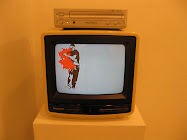DEBRIS: Out-Zoning Houston
Perhaps there is a cabal out there who would like to edit our Wild West urban landscape into a cohesive order. It is possible that the acceleration of Houston’s growth demands a stronger hand to guide the city’s coursing veins of concrete and commerce-pumping engines of steel and glass. Wild, unwieldy burgs have been tamed before and tempered into hardened tools of self-organization, and we’re unlikely to be an exception. The Contemporary Arts Museum’s current exhibit No Zoning: Artists Engage Houston may be a talisman of this emerging meme, but a cultural uproar threatens to derail this celebration of the city’s mélange.
As rich and chewy as menudo, as accepting as paella, as deeply flavored as gumbo, the hot guts of the Bayou City have Expressionist roots and unpolished edges. From the origins of Texan culture in German, Mexican and African-American communities Houston has inherited blood, pain, pride and earnest low-brow tendencies. Unlike Dallas, Screwston has no artistic foundation in Modernism, no hard-edged clarity, no easy divinity. Toil, sweat and tears are the currencies of Expressionism and Surrealism—both of which grew in the fertile soil of East Texas, Louisiana and Mexico and migrated to Houston.
Our cultural orbits are not as ‘New York-centric’ as the rest of the United States, and the distinct combination of Mexico City’s Humanist influence and Southern outsider Expressionism pushed completion, simplicity and objectivity further from the artistic mood. The Menil Collection’s founding director Walter Hopps called Houston art “Imagist”; he lauded it as a third way between abstract and representational art. For No Zoning curators Toby Kamps and Meredith Goldsmith have gathered 25 years of Houston art, using the economic downturn in museum finances to celebrate the peculiarities of local installation and performance work. Their parsing of the best from the rest is debatable, but the presentation of the exhibit is less beholden to the whims of subjectivity.
No Zoning invites comparisons with two seminal CAMH exhibits in Houston’s emerging art history, Fire!, 1979, and Think Twice, 1995. Fire! was a local group show of over 100 artists that changed the course of our structural artworld. It ended in a messy, drawn-out food fight that horrified aristocratic board members and prompted the firing of museum director James Harithas, who had come to Houston from Washington DC and the helm of the venerated Corcoran Gallery of Art. The community’s repudiation at the hands of the board soured tastes on both sides of the divide, and accelerated the growth of alternative spaces in Houston. The artists exhibiting in Fire! were dominated by Expressionist painters and sculptors-- crude and visionary, emotional and tactile. After the schism, no Houston artist would exhibit in the main gallery for 15 years.
A solo exhibition by The Art Guys, Think Twice broke the long dry spell for the home team and reengaged the community that had come out in droves to events at the institutions created in the 1980s like Lawndale Art Center, Diverseworks and The Art Car Parade. Filled with low-brow treats mocking institutional hermeneutics with surreal project proposals, impermanent sculptures and a giant nose that blow green snot, the exhibit was a resounding success that went on to become the highest attended exhibit at the museum ever. Not only were The Art Guys lauded but the Bayou City’s cultural core was tacitly vindicated of its bad name in society circles as other Houston artists climbed respectable ladders. 14 years after Think Twice, No Zoning hopes to grab the brass ring in many of the same ways, but its misinterpretation of key elements of this culture’s successes blunts its ability to convincing evaluate the sprawling Petri dish on the banks of Buffalo Bayou.
Young artists have soundly criticized No Zoning for being lukewarm, sanitized or confused. Their issues stem from both omitting the old standbys of Houston art and not paying attention to newer artists. They wonder why The Flower Man is outside on the front lawn and how Notsuoh, Jim Pirtle’s bizarre barroom creation on Main Street, can be half-heartedly recreated in the gallery space. Nestor Topchy, former denizen of the utopian urban colony Templo, is coolly represented by uninspiring architectural drawings. Some disparage the complete lack of painting, long a staple of Houston Expressionism. Others were searching for a truly living culture and were disappointed by work stripped of its context.
Some artwork seems irrelevant; Knitta Please has done large amounts of their work in every hip city in the world other than in Houston, and the “collective” is racked by internal molting that has left them a bad reputation among many a young artist. If Knitta has responded to Houston, it must have been a bad reaction. I cannot tell why Lauren Kelley, despite her strong body of work, is included in No Zoning. Her stop-motion animation tales of growing up and navigating our conflicted American social mores has little to do with the specificity implied in the show. The performances of Mary Ellen Carroll and films of Andrea Grover evaporate when there is not a scheduled event; during museum hours visitors are left wanting, staring at an empty stage.
For all the good intentions of No Zoning, its presentation leaves much to be desired. If nothing else the large amount of chatter around it is a positive development, bringing dialogue to the community where there previously was none. One can only hope that it leads to all the intriguing alternative spaces and artists across the city that more accurately portray Houston’s sprawling, metastasizing culture.
























1 comments:
As part of the "old guard" that was active in the 90's, much of what transpired was experiential. You had to be there. Tough to bottle non-institutional energy inside an institution. As part of the show, I did the best I could to bring the raw energy of a non-institutional sculptural action into an institution, and had fun doing it. But I'm not in the business of compartmentalizing what artists do under a conceptual umbrella called 'No Zoning'. I too question why some artists, including myself, are in the show, but that's not my job. I at least have to give credit to curators new to Houston having the interest in exploring what is and has gone on in their back yard. Any show that produces dialogue is good for the community, no matter how ill conceived some people may see it. So I say to the young, middle aged, and old artists in town, don't get mad, get to work. You are creating your own history, no matter if anyone is paying attention or not.
Post a Comment